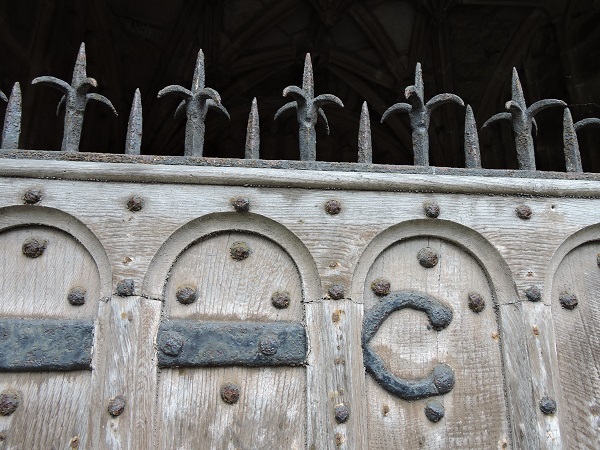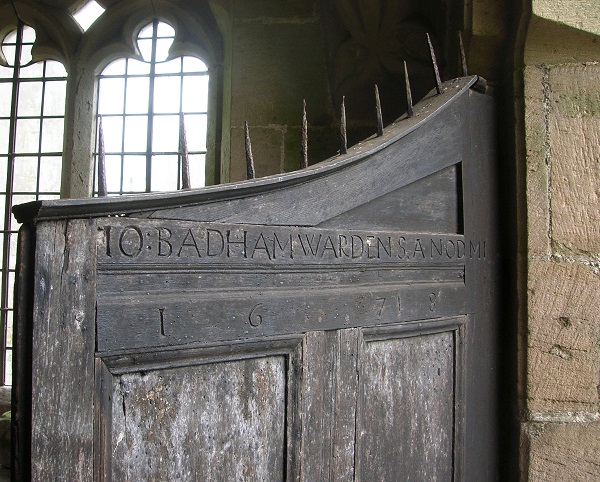Porch Gates
Linda Hall
 |
|
| St Andrew's, Broadhembury: the design of the turned balusters, the fielded panels and the ramped top rail all suggest an early 18th-century date. (All photos: Linda Hall) |
How many times have you stopped and looked at the porch gates before entering a historic church? Occasionally? Never? Many churches do not have porch gates, while some have outer doors, but a surprising number of fascinating and historic porch gates survive. Sometimes these are in a rarely used porch, while the current entrance has plain functional gates that may be quite recent. A Google image search will also produce interesting modern examples. Yet these gates are never mentioned in books about church architecture and very rarely mentioned in Pevsner’s Buildings of England or in church guide books. It is as if they are invisible.
Porch gates perform different functions in different places. Some are clearly designed to keep intruders out, with locks, bars and a fearsome array of wrought iron spikes on the top. Others are lower and spike-less and were perhaps intended to keep out dogs, cats and other animals rather than human intruders. More recent examples often include a mesh to prevent birds from flying into the church, especially where the main door is kept open as a sign of welcome.
The oldest surviving gates appear to date from the 17th century, with many more from the 18th century and later. They come in three main types. Some are of solid plank or panelled construction like doors, while others have an open framework of posts, rails, wooden slats or ironwork. The third type combines the two, with a solid, often panelled, lower section and decorative spindles or balusters in the upper section. Pairs of gates seem to be more common than single gates and are often more pleasing to the eye.
Some porch gates are almost doors filling the entire arch, but qualify as gates by including ventilation in their design. The south porch of Holy Trinity, Much Wenlock (Shropshire) has a splendid pair of late 17th- or early 18th century doors with alternating rows of tall and square fielded panels, with a panelled top section almost filling the head of the arch. The narrow gap left for ventilation is filled with beautiful wrought iron spirals. The equally magnificent gates at St Peter’s, Oundle (Northamptonshire) have heavily moulded fielded panels, typical of the later 17th century, while ventilation is provided in the upper section by a sunburst effect of tapered slats radiating from the centre.
Holy Cross, Sherston (Wiltshire) has a wooden porch with very striking and unusual openwork gates composed of elaborate ‘splat’ balusters set in a two panelled framework under a cusped head (splats are flat in profile and have either straight or symmetrically shaped sides to produce a more decorative effect). The balusters appear to be late 17th or early 18th century in design, although the overall composition looks later. Simpler versions exist elsewhere. A door composed entirely of plain splats fills the arch at St Peter’s, Wormleighton (Warwickshire) and has a simple wooden latch. The gates at St Mary’s, Priors Hardwick (Warwickshire) each have two recessed vertical panels with an upper section of vertical square struts; an 18th-century date seems likely. St Pol de Leon, Paul (Cornwall) has a probably 19th-century version, with a smaller, solid section comprising narrow flush planks.
17th-century gates are often of plank construction with moulded fillets covering the joints. At St James, Charfield (Gloucestershire) the strap hinges run under the fillets and are set into the planks, while a strong drawbeam and lock on the inner face show that they meant business. The gates at St James, Dursley (Gloucestershire) could be earlier, perhaps even 16th century. They have a simpler moulding to the applied fillets which divide each gate into five vertical panels with rounded heads. Heavy strap hinges run under the fillets and the gates are topped by alternating plain and four-pronged wrought iron spikes. The timber west porch at St Bartholomew, Otford (Kent) has square-headed plank doors with heavy applied mouldings forming six panels on each. The porch is ventilated by sturdy turned balusters running the length of each side and is dated 1637 on a decorative pendant at the apex of the roof. The north porch of St Mary, Pembridge (Herefordshire) has a pair of four-panelled gates, inscribed ‘THO : BENGOVGH : AND : IO : BADHAM WARDENS : ANO DMI 1678’. The gates are topped by curved sections bearing a row of sharp iron spikes; the wood is less weathered and it is tempting to believe these sections were added in the 18th century.
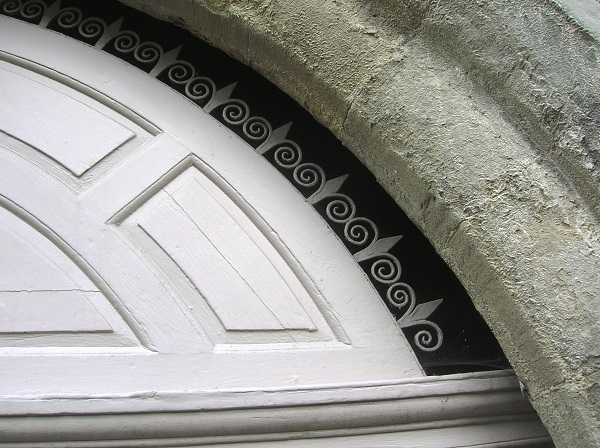 |
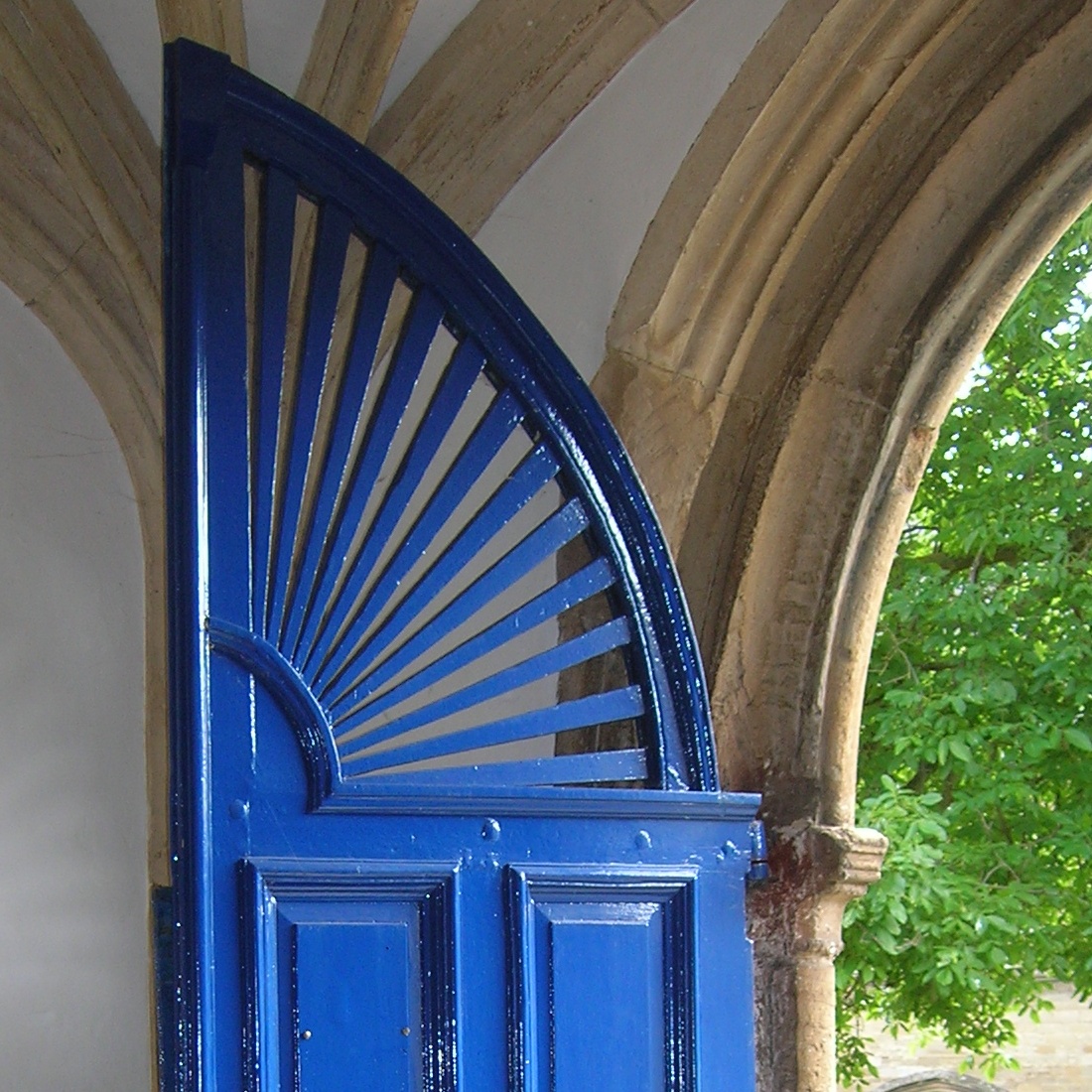 |
|
| Holy Trinity, Much Wenlock: these wonderful panelled gates to the south porch date from the late 17th or early 18th century. The space for ventilation is unusually small and the ironwork takes the common form of a lozenge-shaped spike with a spiral on each side. | St Peter, Oundle: these handsome doors date from the late 17th century. The sunburst effect forming a ventilation panel filling the head of the arch is most unusual. | |
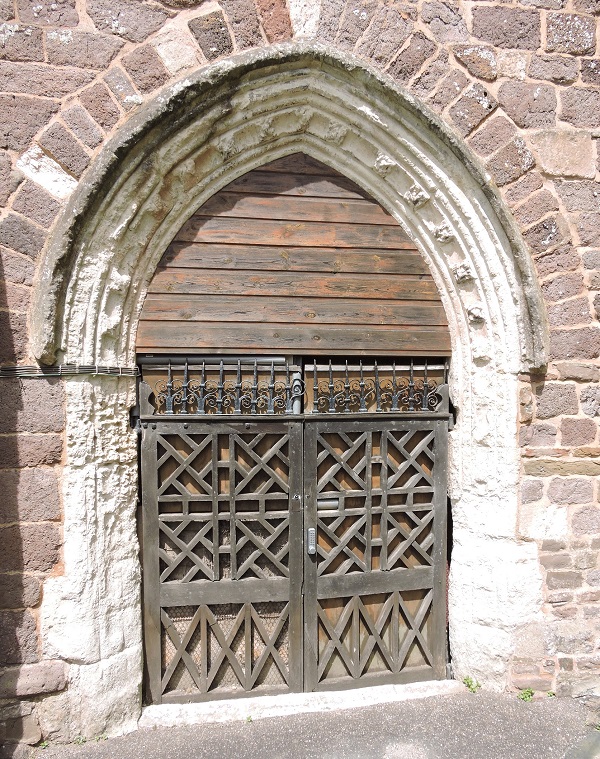 |
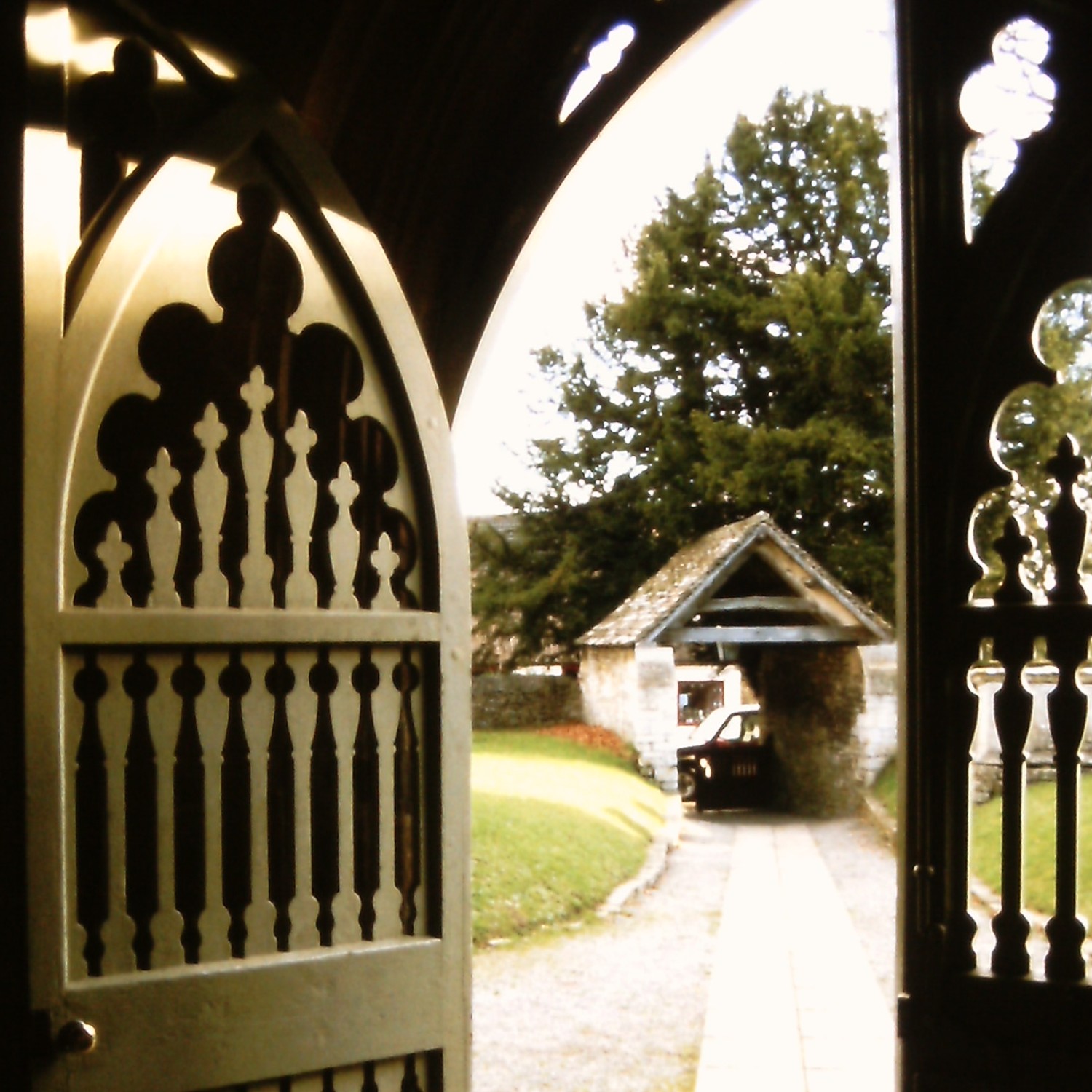 |
|
| St Andrew's, Cullompton: looking somewhat forlorn in the unused south porch, these gates of Chinese Chippendale design are nevertheless impressive and unusual, with beautifully executed ironwork.. | Holy Cross, Sherston: this wooden porch and its openwork gates with dramatic cusping superficially look 19th century, but the design of the splat balusters suggests that it nay be 18th century. |
The two-panelled gates at St Martin, Dunton (Buckinghamshire) have ramped tops and date from the early 18th century. They are quite low and would be easy to climb over were it not for the row of fearsome spikes along the top. The gates at St Mary’s, Winterborne Stickland (Dorset) are taller and also have a ramped top and spikes, but are constructed of two layers of planks, the inner layer horizontal and the outer layer set diagonally. The north porch of Wells Cathedral has even taller ramped-top gates, each with nine recessed moulded panels. The strap hinges are the full width of the gate, the upper ones following the curve of the ramped top. The spikes are attached to the top of the gates by a metal plate which folds over the sides. Inside the cathedral at the west end are two pairs of gates with large panelled doors. The tops are curved in such a way that when the gates are closed they almost form a semicircle. This feature is also found at St Cuthbert’s, Wells, where the south porch gates have fielded panels but no spikes, and at St Saviour’s, Dartmouth (Devon), with recessed moulded panels and very large spikes with a spiral twist.
The same concave curve occurs at St Brannoc’s, Braunton (Devon) where the gates to the unused north porch belong to the second type of gates, with a framework of posts and rails infilled with spindles, slats or ironwork. Here the middle rail follows the curve of the top rail and the infill consists of slender spindles of alternating twisted and ovolo-moulded design. The posts and rails have a bead moulding and the gates are topped with alternating leaf-shaped and twisted iron spikes, now sadly rusting through the paint. St Mary’s, Isle Abbotts (Somerset) has more substantial alternating twisted and turned spindles, a slightly curved top rail and strap hinges which return down the central posts. The handsome spikes alternate simple lozenges with fleur-de-lys designs. These both appear to date from the 18th century but St Mary’s, Debenham (Suffolk) has a pair of early 17th-century gates with two rows of turned balusters with slender spikes on top. The steep stair in the western two-storey ‘porch’ (Pevsner calls it a Galilee) has newels and balusters of the same design. The disused south porch of St Andrew’s, Cullompton (Devon) has unusual Chinese Chippendale gates topped with tall spikes with multiple scrolls which probably date from 1770–90. The lower section of saltire crosses appears to be a repair and may not follow the original design.
Most gates of this type are much less decorative and can be plain in the extreme, but visit on a sunny day and their shadows on the porch floor can be dramatic. Top rails may be straight, have a gentle downward curve, or be ramped at the ends and may have a simple bead moulding. Studs can be square or set diamond-wise, while the splats may be plain or have decorative tops. St Mary’s, Grosmont (Monmouthshire) has decorative splats with finials on the side posts of each gate. All Saints, Monksilver (Somerset) has a ramped top rail, bead mouldings on the main members and diamond studs with a little finial on each. Like many gates, they have been extended to fill the entire arch with a modern framework and metal mesh. The charmingly rustic gate at All Saints, Billesley (Warwickshire) also has diamond studs with little finials and a curved top rail. The otherwise plain splats at St Peter and St Paul, Kedington (Suffolk) end in a little twist and the gates have a dramatic curve, with the tallest splats in the centre, while St Mary, Gislingham in the same county has a single gate with three rails, the top one curved, and plain splats.
Many iron gates follow the same basic pattern of vertical and horizontal members, with more or less embellishment depending on size, location and date. Many are very hard to date but some certainly date back to the 18th century. The west porch gates at St Mary’s, Usk (Monmouthshire) have a central spiral finial that looks 18th century, while St Oswald, Malpas (Cheshire) has a fine pair of wrought iron gates made by Thomas Tomlinson in 1767 (Pevsner).
Perhaps the most attractive gates are those which have a lower panelled section and an open upper section filled with turned balusters, simpler studs, or ironwork. The lower section may have a single horizontal panel on each gate (St Martin, Elworthy, Somerset), one large square panel (St Mary, Dunsford, Devon) or two vertical panels (St Andrew, Broadhembury, Devon). At St James, Dorney (Buckinghamshire) the brick porch is dated 1661 and the pair of gates is undoubtedly the same date. Each has four turned gun-barrel balusters above a plain panel with applied moulding forming a lozenge. Broadhembury and Puddletown have very attractive turned balusters of early 18th-century design and while the latter has simple spikes along the top, the former has the most elaborate set of scrolled spikes above a row of egg and dart moulding, with a rosette at each outer corner. Pevsner calls it ‘a C17 wooden gate’ (at least he noticed it).
St Peter’s, Shaftesbury (Dorset) has equally extravagant features, with the curved and moulded top rail of each gate finished with a beautiful scroll. The iron spikes have tightly curled scrolls, with an S-shaped scroll atop the outer post. Instead of turned balusters there are four diamond-section studs in each gate. Diamond studs are also found in the very handsome gates in the north porch at St Mary’s, Usk (Monmouthshire), where they are finished with tiny sharply pointed finials. Medbourne (Leicestershire) also has diamond studs which protrude through the ramped top rails, and the gates are finished with ball finials on both inner and outer posts. They are fastened by a simple iron hasp and a modern padlock, and were perhaps more effective at keeping dogs out than humans. Dunsford (Devon) has slender turned balusters of a simple design typical of the mid- to later-18th century, with a ramped top rail and no spikes.
The single gate at St Mary’s, Nettlecombe (Somerset) has two horizontal panels and an open section with moulded studs and rails forming three rows of six squares. The only remotely similar gate is at St Melangell, Pennant Melangell (Montgomeryshire), where the pair of gates bears the date 1763 and the initials ‘SO’ and ‘EM’, presumably the churchwardens of the time. Here each gate has two square fielded panels, with an open lattice above formed from plain slats, and like Nettlecombe the top rail is ramped. The execution is much less precise, however, and nothing is quite square, giving a rustic charm.
Even more unusual are the handsome gates at St Mary’s, Ross-on-Wye (Herefordshire) which have the upper panels filled with elaborate wrought ironwork. Further ironwork on top of the ramped and moulded top rail fills the space between the gates and the ironwork filling the head of the arch. Much simpler but equally pleasing ironwork partially fills the round arch at St Martin, Welton-le-Marsh (Lincolnshire), where the western tower forms a porch. The simple gates have plain vertical slats above flush panels, but the lintel carries five decorative spikes, graded in size, each with a twisted central shaft carrying four leaves.
Historic church porches are often full of interest. Outside there may be boot scrapers or a decorative path; inside may be old benches, an interesting floor or roof, or a holy water stoup. Linking the two are the porch gates, of a huge variety of styles and dates but always worth a closer look. The author would be delighted to hear of other interesting examples.



